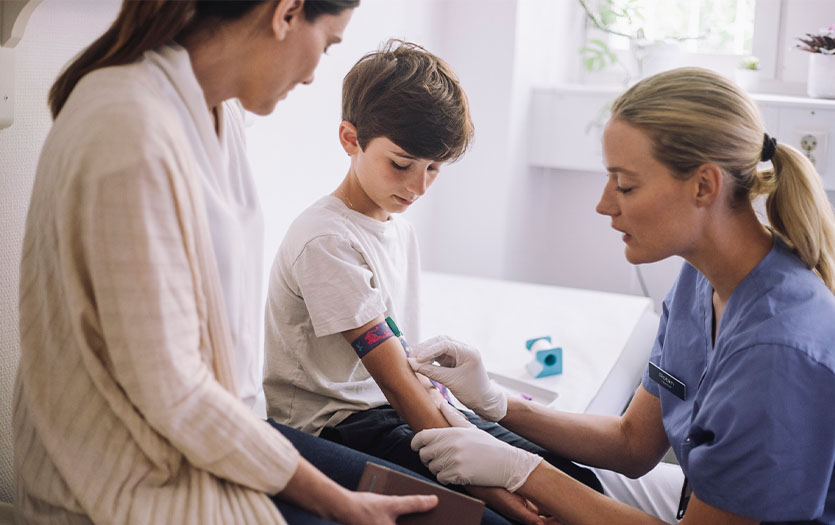
Despite the reduction of lead exposure through environmental laws in the United States, lead remains a significant health risk, especially for young children. The consequences of lead exposure can be severe and often irreversible. According to research published by the World Health Organization (WHO), each year, an estimated 1 million people die from lead poisoning, with millions more exposed to low levels of lead, causing lifelong health concerns. Below, we cover the risks associated with lead poisoning, the testing process for diagnosis and treatment guidance.
What is lead poisoning?
Lead is a naturally occurring element found in small amounts in the earth's crust. Lead poisoning occurs when an individual absorbs too much of the poisonous metal. No amount of lead exposure is considered safe and poses significant risks to all age groups. A person can be exposed to lead through:
-
Eating or drinking lead-contaminated foods, water or other materials such as paint chips
-
Breathing dust or smoke containing lead
-
Skin contact with lead
Additional data from the WHO advises that young children are especially vulnerable to lead poisoning, absorbing 4 to 5 times more lead than adults from the same source. Excessive lead in children can impact behavior, hearing and learning, as well as hinder the child's growth.
In adults, it can damage the brain, nervous system, stomach and kidneys. Prolonged exposure can also cause high blood pressure and other health problems. Lead exposure in pregnant and breastfeeding women is particularly concerning, as it can be passed to the baby (fetus) during gestation and through breast milk.
Diagnostic testing
The effects of lead poisoning may not be immediately apparent, as symptoms can take time to manifest. If a child or adult is exposed to lead, speaking with a pediatrician or primary care provider for an accurate diagnosis is essential. If the physician suspects lead poisoning, they will likely order a lead (Pb) test, which measures the amount of lead in a person's blood. This test can be performed using different methods depending on the individual's age or specific situation. Standard drawing techniques include:
-
Blood sample from a heel stick- A heel stick is used to obtain a blood sample from a baby. During the procedure, the infant's heel is poked, and several drops of blood are collected. The baby may have a tiny bruise at the collection site.
-
Blood sample from a vein- For older children and adults, a healthcare professional takes a blood sample, usually from the arm, using a needle.
Following blood draws, individuals may go home and return to their usual activities immediately. Lead test results are usually available within one week.
Understanding lab results
The lead lab test results are interpreted based on reference ranges provided by the laboratory, which indicate a normal level of lead in the blood. These ranges are guidelines, and healthcare providers consider the results in the context of the individual's age, overall health and other relevant factors.
A lead level outside the normal range does not necessarily indicate a problem but may warrant further evaluation. Physicians typically recommend additional testing if:
-
The child is 1 to 5 years old and has a blood lead level of 5 micrograms per deciliter (mcg/dL) or higher (or 0.24 micromoles per liter (mcmol/L) or higher).
-
The older child or adult has a blood lead level of around 10 mcg/dL or higher (or 0.48 mcmol/L or higher).
The timing for a follow-up test can vary based on the detected lead levels. Slightly elevated levels may require retesting in a month, while high levels could necessitate a second examination within a few days.
Treating lead poisoning
Identifying and removing the source is the most effective method for treating lead poisoning. The Centers for Disease Control and Prevention (CDC) suggests checking these potential culprits:
-
Paint chips, flakes or dust in homes or buildings built before 1978
-
Soil contaminated with lead particles from exterior lead-based paint, leaded gasoline, aviation fuel and lead industries
-
Water that has been in contact with lead pipes, faucets or plumbing fixtures
-
Some children's products and playthings, especially imported or antique toys and costume jewelry, may contain lead.
Additionally, the CDC recommends eating a diet rich in iron, calcium and vitamin C to reduce lead levels in the body. In cases where levels are very high, chelation therapy may be necessary. This treatment uses medications to lower the amount of heavy metals and minerals in the body.
Learn more
Lead exposure can have severe and lasting effects, especially for children. The risks increase the longer it goes undetected. If you or a loved one have been exposed to lead, contact your primary care provider to discuss your options for testing.
Lab testing can be scary for young kids. That's why Parkview Pediatric Lab & Imaging offers a specialized draw site for those ages 14 and under. Our highly trained, full-time phlebotomist is dedicated to providing gentle care to make the experience as comfortable as possible. For added convenience, no appointment is necessary. To learn more about pediatric laboratory services, call 260-266-5400.
Copyrighted material adapted with permission from Healthwise, Incorporated. This information does not replace the advice of a doctor.



